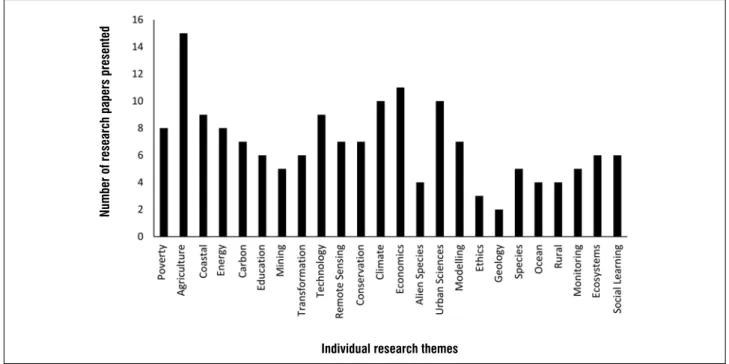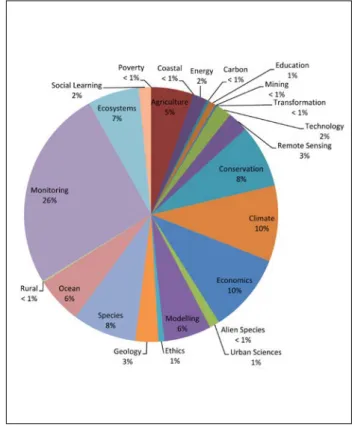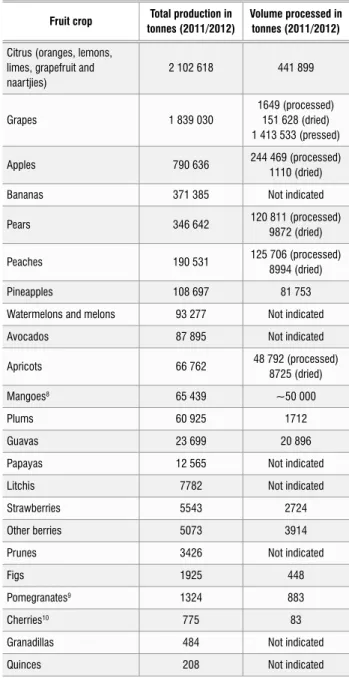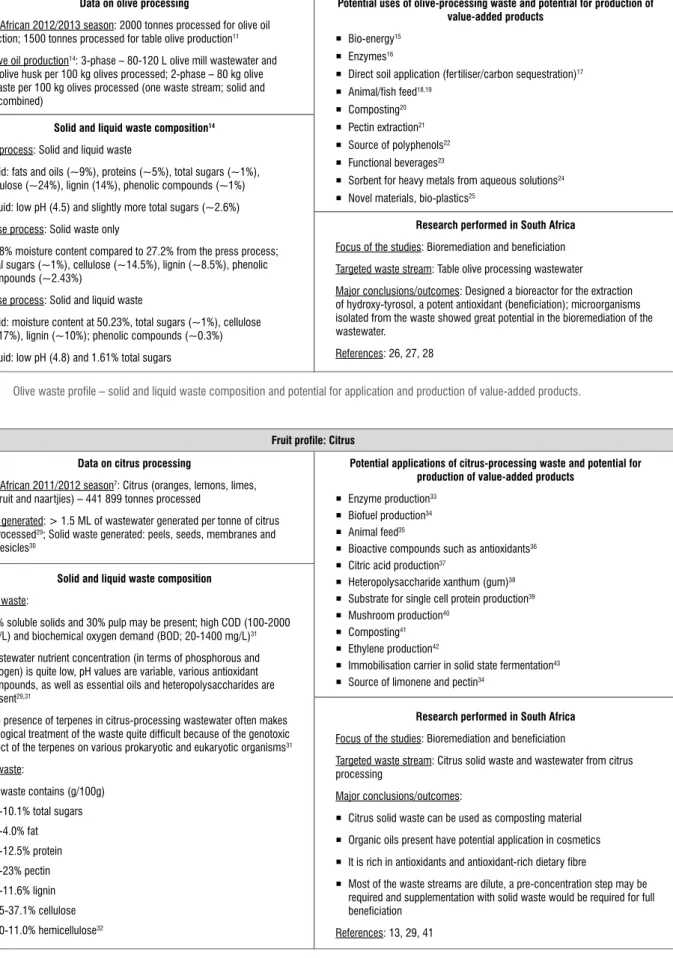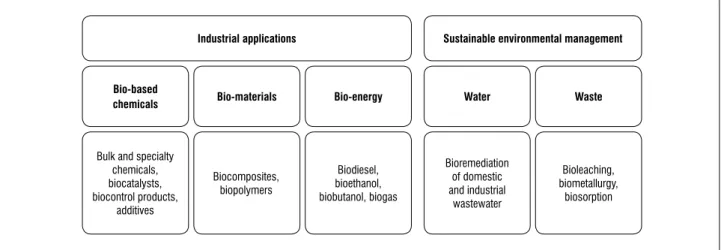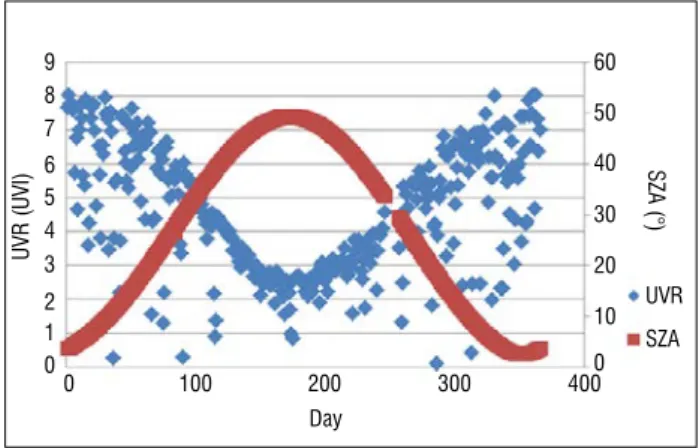School of Animal, Plant and Environmental Sciences, University of the Witwatersrand, Private Bag 3, Wits 2050, South Africa. The author's personal views do not represent the views of the University of Cape Town.
It is important that there is a recognition of the need for change, without which there will be no progress. The social origins of black intellectuals in sub-Saharan Africa lie in colonial times, particularly in the later decades of the 19th century.
Global change background
The South African Department of Science and Technology's (DST) Global Change Program (GCP) is one of the 'Grand Challenge' programs that includes a 10-year Innovation Plan that aims to transform South Africa into a more large knowledge-based. by stimulating interdisciplinary research to solve, among others, the specific needs of energy, economy, society and technology. We base our analyzes of transdisciplinarity after accounting for the level of transdisciplinary research across different themes presented at the 2nd Biennial Conference on Global Change (CGC), held in early December 2014, at the Nelson Mandela Metropolitan University in the Eastern Cape.
A method for analysing transdisciplinarity
At the outset, DST's Global Change Research Plan identified four key cross-cutting knowledge challenges – understanding a changing planet, reducing the human footprint, adapting the way we live and innovating for sustainability – and 18 other key research themes ( for more details the reader is directed to: http://www.gov.za/documents/ .global-change-grand-challenge-national-research-plan). For 5 years, the Global Change Grand Challenge initiative has supported science and technology, as well as key socio-economic development and environmental research projects across the country in most universities and national research institutes, to meet these challenges.
Results of the analysis
Here we present a numerical model for analyzing the level of transdisciplinary research shown within the GCP. To do this, our model is applied to the Conference for Global Change (The complete conference program is available at http://globalchange2014.nmmu.ac.za/ . Program).
Lessons learned
This goal is certainly part of South Africa's plan to move towards a knowledge-based economy. Department of Human Biology, Faculty of Health Sciences, University of Cape Town, Anzio Road, Observatory 7925, South Africa.
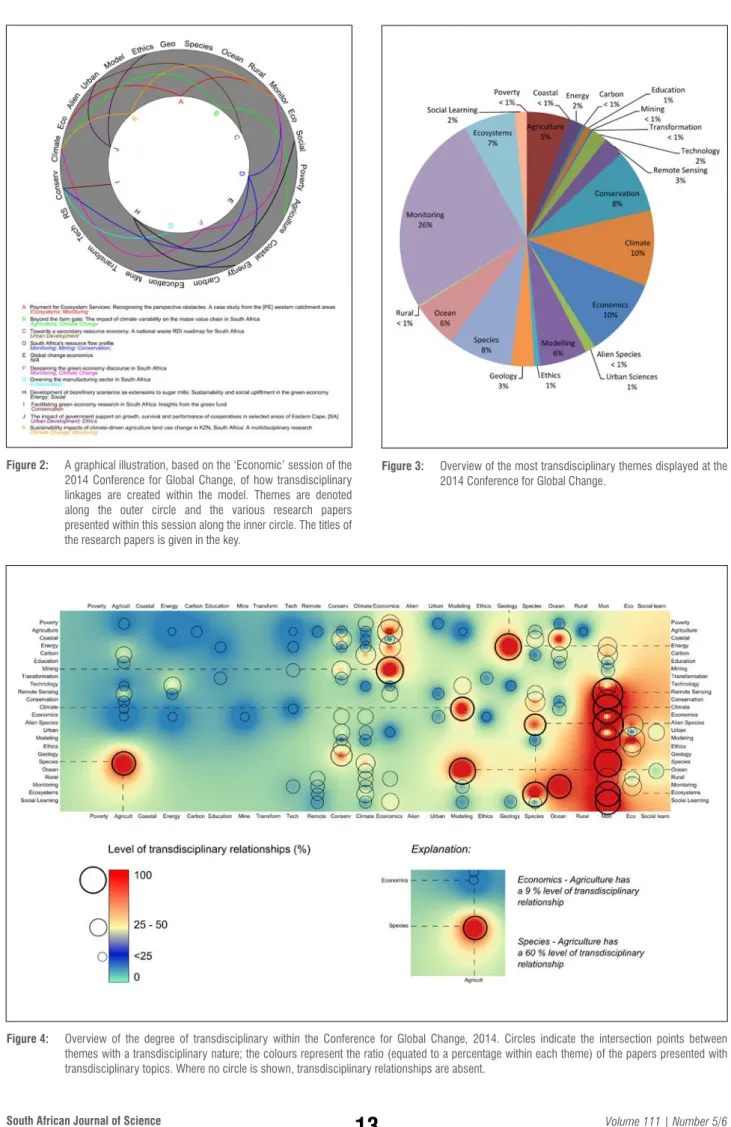
Introduction
Finally, to maximize the use of waste streams in South Africa and abroad, a conceptual model of an integrated system using different technologies is proposed. The olive industry is one of the fastest growing agricultural sectors in South Africa with a growth rate of approximately 20% per year.
South African studies on bio-based (fruit) wastes
Research conducted in South Africa Focus of studies: Bioremediation and beneficiation Targeted waste stream: Table olive processing wastewater. Anaerobic ponds for the treatment of apple processing wastewater are effective for bioremediation of wastewater and can be applied to biogas (methane) production.
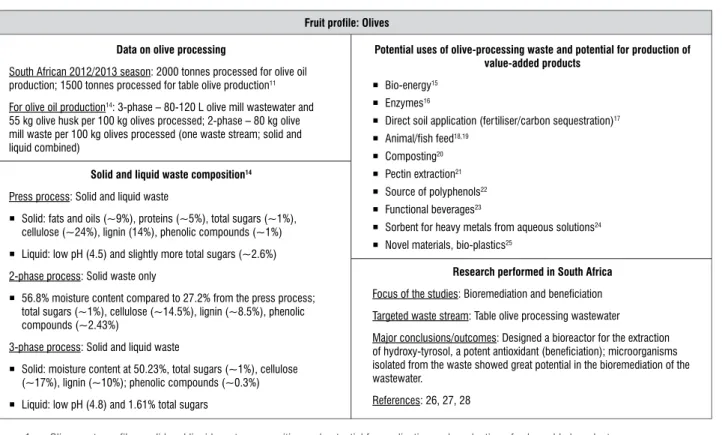
Production of value-added products from bio- based (fruit) waste
Although the beneficiation aspects and application of fruit waste as feedstock for renewable energy generation have been the focus of fruit waste studies in South Africa, there have been no studies related to the production of enzymes as value-added products. with fruit waste as raw material. The following sections will focus on the feasibility of fruit waste and waste streams as feedstock for the production of value-added products, including industrially important enzymes.
A conceptual model to maximise utilisation of fruit-waste streams
A biorefinery for fruit waste must not only be able to produce valuable products, but also be sustainable in the long term and generate economic, environmental and social benefits. In addition, the processing of other agro-industrial waste in the region could take place out of season(s) to reduce downtime.
Conclusion
Next, waste streams with lipids and high phenolic content (such as olive mill waste streams) or higher lignocellulose (fruit waste or lemon waste) will be used to produce enzymes with recombinant A. Some disposal strategies for fruit waste (eg use as feed material) utilize all components of the waste.
Acknowledgements
The rest will be exploited for biogas production, or combined with municipal waste for biogas production. Innovative solutions to overcome the challenges are necessary for the implementation and success of the new Bioeconomy Strategy.
Authors’ contributions
Constitutive expression of the Trichoderma reesei β-1,4-xylanase gene (xyn2) and the β-1,4-endoglucanase gene (egI) in Aspergillus niger in molasses and defined glucose media. 2Department of Soil, Crop and Climate Sciences, University of the Free State, Bloemfontein, South Africa.
Historical perspective
In this review, we provide a historical background leading to the current state of land information in South Africa, highlight the country's land information requirements, and outline a way forward in terms of data capture, storage and interpretation by using the latest technological advances. These classes would eventually become the series and landforms of the first edition of the South African soil classification system.5.
Land Type Survey
The state of spatial knowledge of soils, the different scales of research and their possibilities and limitations were summarized for the Silver Jubilee Congress of the South African Soil Science Society in 1978.6 In addition, a series of studies were carried out in different geographical areas. to aid in the quantification of occurring soils and consequently of naturally occurring soil bodies. Despite an ever-increasing body of knowledge, particularly about emergent soils, there was still little information about soil properties and their distribution in many areas of South Africa.
The soil information system into the digital age
At the same time, a large number of other studies, primarily for irrigation suitability, but also comprehensively selected 1:50 000 map sheets, had been carried out by the Soil and Irrigation Research Institute, which further improved and expanded soil knowledge. base in South Africa. These studies included the former agricultural regions of the Transvaal7, the Free State8 and the Karoo9, as well as a comprehensive series of studies of the former homelands carried out by private consultants such as Loxton, Venn and Associates.
The current state of soil knowledge
The Tugela Basin study departed from concepts of soil series as a natural soil body by providing the first concepts of locally derived soil classes that were incorporated into a formal hierarchical system of soil classification. Some regions of the country and some soil types were still only vaguely surveyed, so the decision was made to start a nationwide soil survey to remedy this situation.
Soil information requirements
Soil information gaps
It is expected that much (but not all) of the province's soil information has been archived. In this connection, a database of basic soil information is being created across the UK and parts of Europe. 47.
Advanced technologies for data collection and interpretation
However, soil information in numerous university theses and reports remains isolated from a central information system while being publicly available. Finally, effective web-based platforms to capture new soil information from public and private sources and a culture to contribute to a recognized natural resource information system must be strongly encouraged.
Natural resource information system
Impact pathways
Conclusions
Perspectives on the principles and structure of land classification in South Africa: Discussion and practical examples. It is therefore imperative to prevent a similar loss of data and expertise on the Far West Rand - the largest of the remaining active goldfields of the Witwatersrand Basin.
Topical categories of research in the Far West Rand
The event that ultimately led to the dewatering of the Bank Compartment was described in detail by Cartwright22 and Cousens and Garrett23. Swart30, Swart et al.3 and Winde and Stoch1 outlined the possible impact of sinkholes on the charging rate of the dolomite compartments based on historical heavy rainfall events.
Conclusions and recommendations
Surface subsidence and sinkholes in the dolomitic areas of the Far West Rand, Transvaal, South Africa. The application of the gravity method to the problem of soil settlement and sinkhole formation in dolomite on the Far West Rand, South Africa.
Acknowledgement
Surface subsidence and sinkholes caused by lowering of the dolomitic water table on the Far West Rand Gold Field in South Africa. The geohydrology of the dolomitic aquifers of the Malmani Subgroup in the southwestern Transvaal Republic of South Africa.
Data
Ground-based solar UVR measurements from the SAWS UVB biometer for 2 days were superimposed on the handheld meter readings. This plot was overlaid with ground-based solar UVR readings to see the annual distribution of the two readings.
Results and discussion
A calculation was made to determine what percentage of ground-based solar UVR measured with SAWS the UVI meters measured during the study period. A calculation was made to determine the percentage of ground-based measured solar UVR that UVI meters measured during the study period.
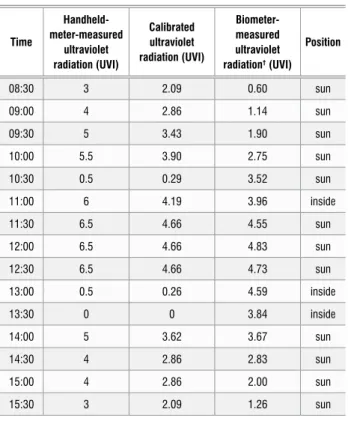
Conclusion and recommendations
We investigated the potential use of cassava stalks for the production of bonded particle boards. We investigated the potential use of cassava stalks for the production of bonded particle boards in this study.
Materials and methods
The ratio between the glue and the cassava stalk had a significant effect on the water absorption of the chipboards. The ratio of glue to cassava stem did not significantly affect the modulus of elasticity of the panels (Table 5; ANOVA, p>0.05).
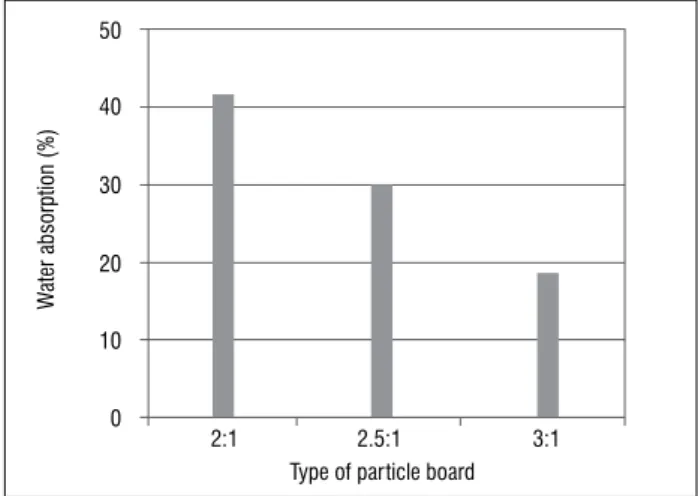
Astronomy for development
1Department of Monitoring and Evaluation, Section of Organizational Psychology, School of Management Studies, University of Cape Town, Cape Town, South Africa. Department of Monitoring and Evaluation, Section of Organizational Psychology, School of Management Studies, University of Cape Town, Office 4.40 Leslie Commerce, Upper Campus, Rondebosch 7708, South Africa.
Evaluating astronomy for development
For example, according to Schilizzi et al.4, the impact of the square kilometer array radio telescope will be widely felt in astroparticle physics and cosmology, fundamental physics, galactic and extragalactic astronomy, solar system science, and astrobiology. Through the SALT collateral benefits program, the construction of SALT is believed to have generated employment, human skills and capacity building, scientific awareness in the surrounding communities, and the development of teacher training and higher education programs.
Challenges in evaluating astronomy outreach programmes
More broadly, a recent article in Nature6 highlights the importance of supporting science and ways of using it for capacity building. Although guidelines for evaluating attitude and behavior change related to informal science programs are available in the literature,22 they are quite broad and will need to be adapted and developed in more depth for specific astronomy-related projects.
Empirical evidence for the effects of astronomy outreach programmes
A programme theory for the astronomy outreach programmes
The templates will be available to program managers in online or hard copy format, depending on technological standards within the country concerned. For the sake of brevity, the templates are not included here, but are available from the corresponding author and the OAD website.35 However, the three surveys that are included appear in the data collection templates.
Programme theory for the Universities and Research Programme
This last step is particularly important for developing countries where data collection and management may not be the norm. OAD will require program managers to use data from these templates when submitting regular progress reports.
Programme theory for the Children and Schools Programme
3 Sometimes I can't stop thinking about the things astronomy teaches us 4 I'm excited to talk to friends and family about what I learn from astronomy 5 I'd like to read more about astronomy on my own outside of class 6 When I look at the sky , I forget the bad things that worry me 7 Learning about astronomy has shown me that I am part of a very big world 8 Learning about astronomy has opened my mind to other people who share my interest. 8 Learning science opened my mind to other people who are interested in my interest 9 Learning astronomy in science class was exciting.
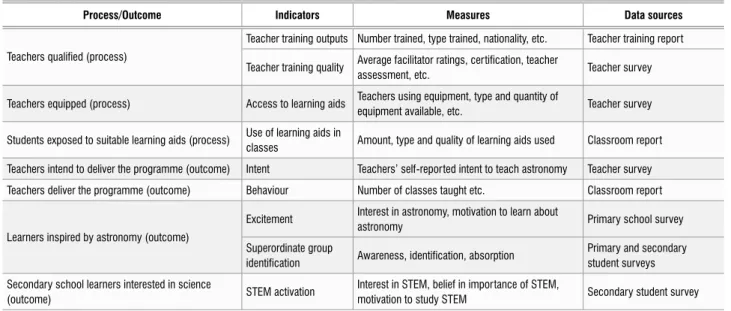
Programme theory for the Public Outreach Programme
Interpreting outcomes
Corrective actions taken by the program will vary significantly depending on the type of failure implied. Failure of service utilization, on the other hand, may mean that beneficiaries did not respond to the program in the way intended, or that the wrong beneficiaries were targeted in the first place.
Understanding process
The second potential reason for a failure to achieve outcomes may be that the program theory itself is implausible. For us, the implications of a theory failure are potentially far more significant than those for an implementation failure, because in the event of theory failure, the strategic objectives of the program in relation to project activities may need to be re-examined and possibly revised.
The next challenge: Measuring impact
In this study, however, the teachers' proficiency was located close to the average of the item locations. Furthermore, the levels of almost one third of the group were below those of all the Level 3 and Level 4 items in the test.
Rasch measurement theory
The location of the item is identified as the point on the ability scale where the probability curves for 0 and 1 intersect. Out of the group of approximately 350 teachers, 286 agreed to participate in this study.
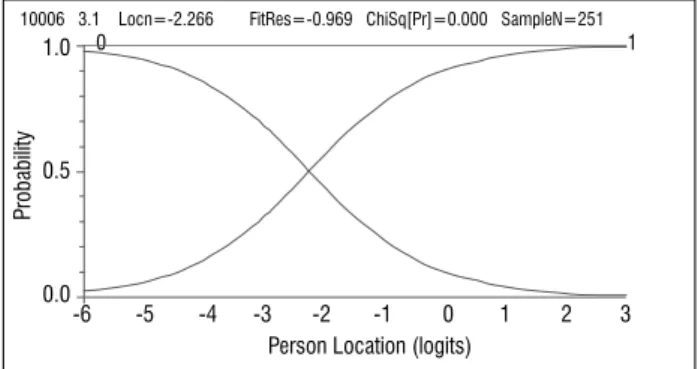
The results of the Rasch analysis
For the distribution of the items, the fitted residual statistic shows slight differences from the initial statistics. The standard deviation of the fit residual moved closer to the ideal figure of 1.

Discussion and concluding remarks
The fit residual mean for the items has become a larger negative number, slightly further away from the ideal of 0. The mean of the person locations at 0.4556 logits was close to zero, suggesting that the test was a bit easy on the sample .

Results
Dryland salinity occurs as a result of changes in land use (native vegetation for agriculture and/or pasture) which cause a change in the water and salt balance of the landscape and which consequently mobilizes stored salts. The objective of this study was to quantify the salinity fluxes in the Sandspruit catchment, a tributary of the Berg River.
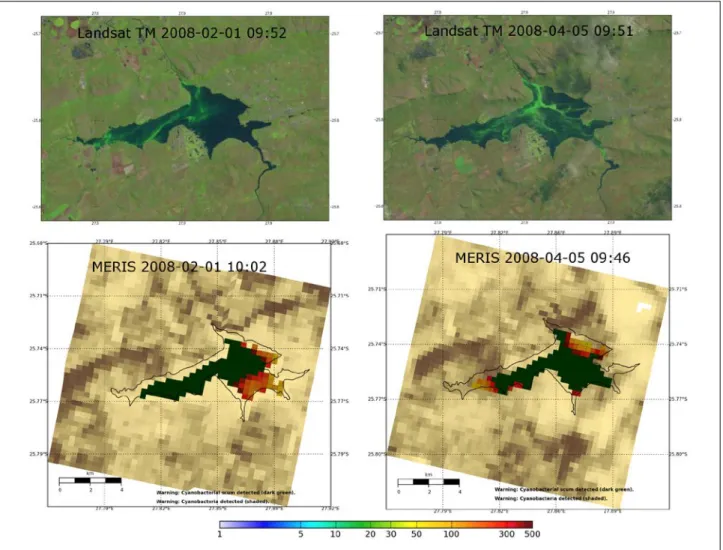
Study area
Flügel9 suggested that salt distribution in the Sandspruit catchment is a function of the topographic location. The reduction in the salt storage range from that reported in Table 4 is a result of the interpolation process.
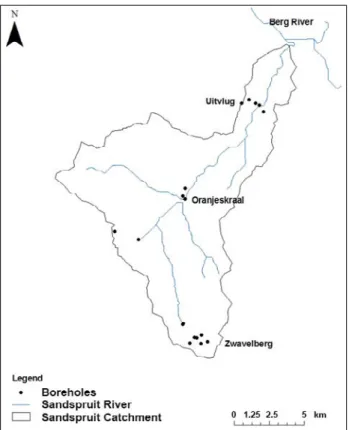
SOUTH AFRICAN
APPLICATION OF SCIENTIFIC THOUGHT IN THE SERVICE OF SOCIETY Our vision is to be the top organization for science and science in South Africa, internationally respected and connected, its membership simultaneously the aspiration of the country's most active scholars in all fields of scientific inquiry , and the collective resource for the professionally managed generation of evidence-based solutions to national problems.
Journal of Science
